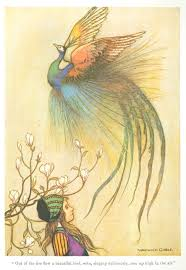“The
Juniper Tree” by the Brothers Grimm: A Tale of Darkness and Justice


“The
Juniper Tree” by the Brothers Grimm is a dark fairy tale that tells the story
of a young boy who suffers a cruel fate at the hands of his jealous stepmother,
but later finds justice through magical means. It strongly reflects the idea of
fairy tale justice, where good is rewarded and evil is punished. A rich, kind
couple longs for a child. One winter day, the wife cuts her finger while
peeling an apple, and blood falls on the snow. She wishes for a child "as
red as blood and as white as snow."
The
Wish and the Tragedy
After
months of waiting, she gives birth to a beautiful boy and dies, asking to be
buried under the juniper tree. This tree becomes a central symbol of love,
death, and transformation. The husband remarries, and the new wife gives birth
to a daughter named Marleen. However, she hates her stepson and becomes
obsessed with giving all inheritance to her daughter. The stepmother represents
cruelty and jealousy, while the little boy represents innocence. Her hatred
leads to a terrible crime of murdering the boy by slamming a chest lid on his
neck. It sets the tone for a tale that mixes horror with hope.
Innocence
vs. Cruelty
Marleen
is tricked into thinking she caused her brother’s death, and she weeps in
sorrow. Marleen is gentle, innocent, kind, and deeply cares
for her brother. The stepmother even
cooks the boy’s body into pudding and feeds it to the father. Marleen is loving
and loyal and her silent suffering shows her deep love for her brother. The
father is mostly passive, unaware of what’s happening. The stepmother is full
of jealousy and evil. Her actions bring out the theme of cruelty within the
family. The story explores deep and dark themes like murder, guilt, and
revenge, but also love, rebirth, and justice.
Magic
& Rebirth
Fairy
tales often use supernatural forces to make sure justice is done. The boy is
magically reborn as a singing bird after Marleen buries his bones under the
juniper tree. This act of love and sorrow helps the boy come back to life as a
magical bird. Marleen’s actions show her purity and help bring justice in the
end. She represents the good, caring side of the family and plays a key part in
the boy’s rebirth.

The
juniper tree is a symbol of life, death, and rebirth in the story. The boy's
real mother dies and is buried under it. The tree becomes a sacred place,
connecting the family’s past to the events of the future. It quietly watches
over the children and holds the memory of the dead mother. The boy is
spiritually linked to the tree, which protects and guides his return. It becomes a place of transformation. The tree
is a symbol of justice. In fairy tale tradition, such trees often represent
nature’s power to restore balance. In this story, the juniper tree brings peace
to the good characters and punishment to the evil one.
Justice
Restored
As
a bird, the boy visits a goldsmith, a shoemaker, and a mill, singing a haunting
song that tells the truth of his murder. In return, he receives a gold chain, a
pair of red shoes, and a heavy millstone - symbols of justice and reward. He
returns home, where he gives the chain to his father and the shoes to Marleen.
Finally, he flies above the stepmother and drops the millstone on her, killing
her instantly. After justice is served, the bird disappears into the tree, and
the boy steps out alive and whole once again. Though the story is filled with
violence and sorrow, the magical ending restores peace and order to the family.





Comments
Post a Comment